|
Giessen
Fragment. Gothic-Latin bilingual. DATE: circa A.D. 450. Provenance:
a village near Antinoë, Egypt. Parchment.
Luke
23:11-14, and on the verso, 24:13-17 [for the Gothic], the Latin displays
Luke 23:3-6 and 24:5-9. Text is Old Latin.
A
very interesting fragment, which fragment is now lost. During WW II,
it was completely destroyed in a bank vault it was placed in, water
seepage did the deed. These images are all we have left! (Lowe has also
a script sample, viii, 1200). it seems that a child practiced some writing
on the recto side. This is also a rare sample of a Gothic text without
being a palimpsest. (Images exclusive to this site).
Diessman
reminds us that Frankish soldiers did visit Egypt. This fragment bolsters
Burkitt's contention that the Latin texts developing in N. Italy were
impacted by the Gothic version! The Latin script seems to have been
executed by an Egyptian scribe in my opinion! Text and transcription,
available on my main Latin page.
|
 recto
recto
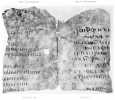 verso
verso
|
|
John
Rylands, Papyrus 472. DATE: circa A.D. 350. Provenance: probably Egypt.
Liturgical text.
According
to Bischoff this presents an old "eastern half-uncial" type
of Latin script. Now resides in the Rylands Library, Manchester, England.
[image sample from Bernard Bischoff, Latin
Palaeography: Antiquity & the Middle Ages. Translated by
Daibhi O Croinin & David Ganz. Cambridge University Press. 1990].
|
 |
|
P.
Michigan 4969. Seneca, Medea 663-704. DATE: circa A.D. 350. Provenance:
probably Egypt. Parchment.
Contains continuous 41 verses (21 on the front and 20 on the back) according
to the current line arrangement. The front has 23 and the back 22 lines.
Page from a vellum codex. The writing is in black ink, there is a rubric
in bright red. The fragment uses two marks of punctuation, a high point
(distinctio) and middle point (media distinctio). There are two high
stops, a few middle stops. Yes Seneca and Virgil were studied and read
in Egypt.
This
sample borrowed from the APIS database (on-line, Michigan.APIS.2364),
I only display one side here. Which side shows also some corrections
in a lighter rust colored ink.
|
 |
|
Codex
Claromontanus, Vatican Latin 7223, Beuron 12. DATE: from A.D. 350 to
550 (see image).
Sample
images are from the gospels of Matthew and Luke. Credit on image. Matthew
is of the Old Latin text.
|
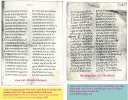 |
|
Oxyrhynchus
papyrus 884: Sallust, "Catilina" chapter 6, recto. DATE: 5th
century. Recto side of a single leaf, from a CODEX. Script has numerous
cursive aspects. Leaf measures 15.8 x 15.4 cm..
Transcription
and sample image is from the Grenfell/Hunt publication, Oxyrhynchus
Papyri, part VI, of 1908. Not many Latin papyri found in Egypt contain
classical texts as does this fine sample!
|
 |
|
Codex
Bobiensis (Beuron 1): DATE: circa A.D.350.
Contains
portions of Mark and Matthew, having a total of 96 pages. Text is Old
Latin. A notable witness to the African type of Latin manuscripts. Apparently
made via an Irish monk who left it to the Bobbio Monastery in N. Italy
upon his death. A very important manuscript illustrating the very literal
translations made before the Jerome/Vulgate recension.
Note
the form of the "A", its pinched bowl is similar to those
seen in the later manuscripts of Tours, France; though these in Bobiensis
are simpler and older.
|


transcription
of sample (ending of Mark)
|
|
The
Cathach of St. Columba: Dublin, Royal Irish Academy, s.n., folio 48r.
DATE: circa A.D. 625
Sample
image shows beginning of Psalms 90. A manuscript often thought to have
been written by St. Columba. An example of very early Irish writing
(here Insular half-uncial script). Note the cross attached to the enlarged
initial, it is very similar to crosses seen in the Book of Durrow. Both
MSS have the typical habit of Irish scripts in that the letters begin
large and gradually diminish in size, known as diminuendo motif.
According
to Julian Brown, these enlarged initials in the Cathach are "proof
positive that Italian influence did reach Ireland by the middle of the
seventh century". [A Palaeographer's View; The Selected Writings
of Julian Brown. pp. 193 f.. 1993].
|
 |
|
Codex
05, Codex Bezae. DATE: circa A.D. 350-600. Contains the Four Gospels
and Acts, with one leaf containing I John 3:11-15. Beuron 5
Greek/Latin
bilingual. Tons of literature available for this MS. Has gospels in
the Western order, Matthew, John, Luke, Mark.
Its Latin side is typically classed as Old Latin. In the sample image,
I rearranged the texts so that you can easily view the two scripts.
No one knows where it was written. Greek and Latin texts are on opposite
pages, [the sample image says "side-by-side" but actually
on opposite pages] written in sense-lines. Aland suggests North Africa
or Egypt as origin locale, I agree. Mercati (J.T.S. vol. XV, 1914) argues
convincingly, that it was not produced in a Greek scriptorium.
I
also suggest that the original Greek text of 05 was probably written
by Dr. Luke and then annotated by Paul while in a Roman prison, when
Dr. Luke visited him. Later, Paul's notes were moved into the main body
by later copyists. (This is my theory).
|
 |
|
Mosaic
floor: Dorset, Britain. DATE: circa A.D. 350
Perhaps
little to do with Latin MSS, but this mosaic floor uncovered in England
is amazing. Proof that Christians were living in Britain circa 350.
Note the Chi-Rho symbol on/near the head of Christ.
|
 |
|
Codex
Aureus Epternacensis. DATE: 1050 -1055 A.D. (per Metz). CONTAINS: Four
gospels. In the Germanisches Museum, Nuremberg, Germany.
Not
to be confused with the other codices named Aureus or the Paris Epternacensis.
This is a Latin manuscript with lots of gold in its images and ornate
cover. A deluxe edition! and probably osculated by many of Europe's
nobilities. Codex contains 135 pages. Parchment, size of page, 17 3/8
x 12 1/4. Commissioned by the Dowager Empress Theophano.
Manuscript
made in Echternach, Luxemburg (in eastern Luxemburg). The monastery
was an Anglo-Irish foundation. However, this manuscript has major Byzantine
affinities, as the Empress greatly emulated Byzantium, and possessed
some of its artworks. The text varies somewhat from the Vulgate. The
script is a very nice Caroline minuscule. Manuscript was partially reproduced
in the work by Dr. Peter Metz, translated into English by Ilse Schrier
and Peter Gorge. 1957. Title: The Golden Gospels of Echternach: Codex
Aureus Epternacensis. The ornate cover was made earlier for another
manuscript. The present manuscript was trimmed to fit this new reused
cover, (i.e. some of the original jewels were removed and others added).
Its
existence validates the fact that even in a Latin (Benedictine) monastery,
we can find not only Vulgate and Irish based works incorporating Old
Latin MSS, but also Byzantine influences. Some of the readings seen
in the manuscript reflect the Greek Byzantine text-type. Some of the
full page images, on purple vellum, with lots of Gold foil, are beautiful
Byzantine "images", as can be seen.
The
website below (in German) was the source for several of the images.
http://de.wikipedia.org/wiki/Codex_aureus_Epternacensis
|
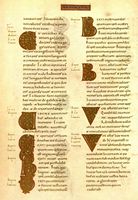

Matthew 4:21 - 5:16
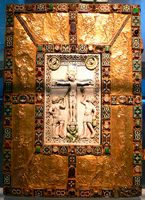
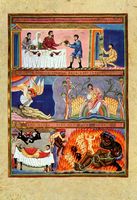
cover
|
|
Codex
Boernerianus (G, 012). DATE: circa A.D. 850. CONTAINS: Pauline epistles
Beuron 77.
A
Greek/Latin bilingual MS. Probably copied or created in the St. Gallen
monastery, and is (most likely) part of the Gospel Codex 037 [shown
below]. Latin text is Old Latin, Greek text seems to be a translation
of the Latin side (so thinks yours truly). Now lies in the Dresden Library,
Germany.
In
my opinion, this is the best of the Latin bilingual MSS of the Pauline
epistles, with a good O.L. text too.
Complete
manuscript available for viewing on the Center for the Study of New
Testament Manuscripts website [www.CSNTM.org]. The MS, in its present
water damaged condition, is also fully available for viewing at/on the
Dresden website.
http://digital.slub-dresden.de
|

|
|
Codex
010 (F, Cambridge, Trinity College. B. XVII.1). DATE: A.D. circa 850.
CONTAINS: Pauline epistles with Hebrews. Beuron 78.
Textually
very close to 012 (above) both from same grandparent. This MS has poor
Greek word divisions. Latin text is Old Latin, similar also to 012 above.
The somewhat elegant Latin script is Caroline minuscule. Text is written
in sense-lines.
|
 |
|
Codex
Cavensis, Beuron C. DATE: 9th century. CONTAINS: 303 folios, parchment,
the descriptions list it as a full Bible. Usually three columns per
page, page size is circa 270mm x 215mm.
A
MS written in Spain. Resides now in Salerno, at the Benedictine monastery
of La Cava. Scripts reflect capitalis, rustica, uncial, half-uncial
and bd uncial. Per Lowe. Typically classed as a Vulgate witness, but
has numerous OL readings in the NT portion. A PDF file on the manuscript
(by E. A. Lowe) can be read here, click on the PDF icon.
Sample
image is also from Lowe.
|
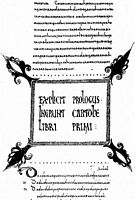

|
|
Codex
Amiatinus, Beuron A. DATE: circa A.D. 730. Contains entire Bible.
Considered
the best witness for the Vulgate version of the Bible. This Pandect
contains 1,029 leaves, on parchment. Written in England (either Jarrow
or Wearmouth). Note text is written in sense-lines. It now resides in
the Laurentian Library in Florence, Italy. Script is Roman/Italian uncial.
Bishop
Biscop (628?-690) founder of the famous Jarrow and Wearmouth monasteries
made no less than five trips to Italy to acquire books, including many
old books from the Vivarium monastery in Calabria (via Cassidorus).
Codex Amiatinus is a beautiful copy of one of the Vivarium manuscripts,
imported to Northumbria by Ceolfrith, and copied by Biscop's scribes.
|
 |
|
Codex
037, or Codex Sangallensis. DATE: circa A.D. 850. Beuron 27. CONTAINS
the four gospels.
Most
likely the first part of the same codex as 012, above. Written at the
St. Gallen monastery, or as stated at the St. Gallen site, written at
the Bobbio Monastery. Latin text is considered Old Latin. The first
image is a copy of what was available, the second image is from the
St. Gallen website, (folio 318, John 1) at which site the entire MS
is available in good full color resolution for viewing and copying.
http://www.cesg.unifr.ch
|


|
|
Codex
Fuldensis, Beuron F. DATE:
A.D. 546. CONTAINS: all of NT and
epistle to the Laodiceans.
Contains
a text like a 4-in-1 harmony (Diatessaron). Probably written in Capua.
Text is not Old Latin. Script is Italian uncial.
|
 sample
shows I Cor. 14
sample
shows I Cor. 14 |
|
Frisingesia
Fragments, Beuron 64. DATE: 450-550. CONTAINS: portions of the Pauline
and Catholic Epistles.
Good
Old Latin text of the Pauline epistles, as well as being a fine specimen
of the African text of the OL. Transcription edition is available elsewhere
on this website. MS now lies in Munich, Germany.
|
 |
|
Codex
Gigas, Beuron 51. DATE: circa 1250. CONTAINS: the Vulgate Bible.
Acts
and Revelation are Old Latin. A giant manuscript, see images. Now lies
in Stockholm, Sweden. Images are available on the Swedish website, but
after zooming-in resolution is not very good. Script is a form of the
Insular half-uncial.
|

 detail
of script
detail
of script
|
|
The
Vespasian Psalter. London, British Lib. Cotton A.1. DATE: 810--850
Latin
text is in an "Uncial script", the glosses are in Mercian,
a form of Anglo-Saxon. Both images of same manuscript, from different
sources. The third image, in the Rustic script is a page from the same
manuscript (borrowed from A History of Writing, Albertine Gaur).
|

 shows
beginning
shows
beginning
of
Psalms 98 - (97 per Vulgate)

|
|
Paris
Bibliothèque Nationale. MS Lat. 11575, folio 1r. DATE:
1164
By
the scribe Johannes Monoculus. Contains a commentary by Florus on the
Epistles of St. Paul. Once was in the Corbie monastery. The script is
what Brown would term as "proto-Gothic minuscule". Image shows
beginning of the Epistle to the Romans. The big enlarged initial is
a fine sample of a "historiated" initial. The name seen in
the initial "Felix" was the artist, and the name "Richard"
who probably commissioned the MS.
|
 |
|
Manuscript
629. Rome, Otto. Gr. 298. DATE: circa A.D. 1350
Nestle/Aland
Greek MS 629. Greek/Latin diglot. The Latin script is very close to
Brown's "Gothic textura rotunda" often seen in France in the
14th century. Which may assist with identifying the MS provenance. Via
my research, the Greek text was written after the Latin, the Latin seems
to have a preference, and it is almost pure Vulgate. The Greek text
seems to conform to the Latin! Image is from a microfilm, shot on a
viewer. Text is I Cor. chapter one.
|
 |
|
Celtic Cross,
Ireland. Date "old", Christian
One of many illustrations which demonstrate the closeness of ancient
Celtic art, imagery and artwork seen in Irish and Anglo-Saxon Biblical
manuscripts.
Some
similar "interlacings" are seen in an illumination/artwork
in the Glazier Coptic Codex, from Egypt. Did Egypt influence the Celts,
OR did the Celts influence the Egyptians? OR are these chance similarities??
In my opinion, this reflects early Egyptian influence up into Ireland.
Do read my essay "The Origin and Value of the Western Text-Type..."
on my main Latin Resources page.
|
 |
|
Book
of Armagh. Dublin, Trinity College 52. Beuron 61. DATE:
807-808
Scribe:
An Irishman, Ferdomnach. Written at the Armagh monastery, Ireland.
Small
pocket sized book, text measures roughly 1.75 inches x 6 inches (per
column). 217 folios per T.J. Brown, 222 leaves per the editor - Gwynn.
Most images of this MS show script which is very small and hard to read.
Script is basically a Caroline/Irish minuscule, which occassionally
lapses into cursive. Gwynn refers to it as "pointed-Irish".
An important Irish manuscript.
Souter
feels that the basic text is OL, with Vulgate intrusions. Whereas Gwynn,
declares, the basic text is Vulgate with OL intrusions. Souter's judgment
here seems more reasonable. MS contains the 4 gospels, (in Vulgate order),
the Pauline epistles, the Catholic epistles, the Apocalypse, and ends
with Acts. Prior to the Biblical texts are two "volumes" one
on St. Patrick and another on "Life by Muirchu". The Biblical
portions may have been produced in 3 separate sections, then later joined
into one volume.
My
evaluation of this MS is that it is a good OL MS, with Vulgate intrusions,
in the Pauline epistles.
A
microfilm, from Claremont, (California) has images which are nearly
impossible to read. Best bet is to use Gwynn's book, of which only 400
copies were made in 1913. Some of the sample images are from a copy
of this rare publication. Each sample image is coupled with the transcription
made by Gwynn, which matches the MS line by line. Book title is: Liber
Ardmachanus: The Book of Armagh. John Gwynn. Dublin. 1913. [folio
size]
|




|
|
Codex
Usserianus primus. Dublin, Trinity College Library, MS 55. DATE: circa
550 Beuron 14.
One
of the oldest Irish gospel manuscripts. Four gospels in the order,
Matthew, John, Luke and Mark, the "Western order". The
parchment (membrane) is of the Continental type (not Insular). The Irish
minuscule script will often have instead of wedges (at the top of the
straight strokes) loops! (as noted in Brown's writings). One such "loop"
is visible in the sample image in the word "Explicit" note
the "l".
|
 |
|
"Grandval
Bible", British Museum, Add. MS 10546. DATE: circa 840
Also
known as the "Codex Carolinus", and as "Moutier-Grandval
Bible". Written in Tours, France; probably at St. Martin. At this
monastery most palaeographers believe the birth of the Caroline minuscule
began. This manuscript is a fine example of that script. Most manuscripts
made at Tours also were in a two column format. Color image borrowed
from the Smithsonian Book of Books. As I understand it,
this is a complete Bible, using Alcuin's revision. It is one of three
surviving illuminated copies produced at Tours.
Note
the three scripts, capitals, uncial, and Carolingian minuscule, this
display of scripts in this order is known as the "hierarchy of
scripts".
|
 folio
26
folio
26
 detail
from above
detail
from above
|
|
The
main hall of the library of St. Gallen.
A
beautiful and great repository of precious manuscripts. Image is a wide-angle
shot, may be best viewed off-site. They display many of their treasures
on their website:
http://www.cesg.unifr.ch
|
 |
|
Stiftsbibliothek,
Codex 51. St. Gallen Library. DATE: circa 750. CONTAINS: four gospels
Text
is typical Vulgate. Script is Irish minuscule. Images borrowed from
the St. Gallen website. Gospel order is typical Vulgate - Mt, Mk, Lk,
Jn.
|


|
|
Map
showing many Latin based monasteries. This map supplements that one
shown on the "main" Latin page on this site. Map is modified
from one printed in Atlas of the Biblical World. Joseph Rhymer,
1982. It of course, does not show all of the monasteries, but enough
to get a good idea of the spread of Egyptian and Benedectine influences.
Many of the earliest Egyptian based monasteries later became Byzantine
rite or Benedectine rite. We can also see how the so-called "western
text-type" of Greek manuscripts spread from their ORIGIN, which
was in Egypt. This western text-type was
later completely Latinized over time.
One
monastery which I added, the Vivarium, in particular spread early Greek
readings directly from Egypt into Ireland, via Cassidorius. These readings
are a part of the western text-type of Greek manuscripts of the Greek
New Testament. One might note the essay, On the Origin and Value
of the "Western Text-Type" as Concerns the Pauline Epistles,
seen on my "main" Latin page.
|
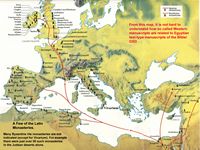 |
|
St.
Gallen, Stiftsbibliothek, Codex 551. DATE: circa 925. CONTAINS: Lives
of the Saints.
Another
fine sample of Caroline minuscule, with some slight variation. Another
reason to visit the St. Gallen website.
http://www.cesg.unifr.ch
|
 |
|
Victoria
and Albert Museum, London. PDP 9037 D. Commentary on Pauline Epistles
by Gilbert de la Porée. DATE: circa 1150.
Copied
in Poitiers, France. The darker script is the Biblical text, the lighter
script on the right in the sample image, is the commentary, written
in a Caroline minuscule.
|
 |
|
Rome,
Bib. Apostolica, Vat. Vat. Latin 5974. DATE: circa 1180. Provenance,
Jerusalem.
One
of three surviving Gospel manuscripts, known to have been copied in
the Latin Kingdom of Jerusalem, Crusader Kingdom. Sample image is folio
62v, Gospel of Luke. The other two Crusader - Jerusalem MSS are: Paris,
Bib. Natl. Latin 9396 and Paris latin 276.
|
 |
|
J.
Paul Getty Museum, MS Ludwig 1, 1. DATE: circa 845. CONTAINS: Romans
1.
A
fragment found in bindings at Trier, but originally made or copied at
Tours. The folks at Malibu have several surviving leaves, the sample
image is folio 7r. Text script is basically a Caroline minuscule, but
note the interesting "g" seen several times (line 8 of text
et al).
|
 |
|
Faddan
More Psalter: National Museum of Ireland, Dublin.
Miraculously
found in an Irish bog. The conservation work has improved its legibility.
Script is a fine sample of Caroline minuscule. Chemical tests place
it in the 8th century, as well as estimates by professional palaeographers.
This is the only image I have yet found, it is difficult to clearly
see the script, yet it appears to be circa 850 A.D. in my opinion. The
lack of oxygen deep in the bog prevented the leather from decay. It
may have been hidden in the bog to save it from raiding Vikings!
It
has some illuminations seen in some of its folios. On its cover, remains
of gold lettering have been found, and papyrus has been used as part
of its bindings. I copied the image seen on page 68 of ARCHAEOLOGY,
July/August, 2011. I then modified it, to make it suitable for a web
page. ARCHAEOLOGY is a useful and very interesting popular magazine.
Though the resolution is poor, one can get an idea of its script. Expect
more, in the future from the folks in Ireland!
|
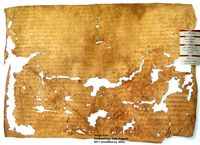 |
|
Book
of Mac Regol. Oxford, Bodleian Library, MS Auct.D.II.19. DATE: circa
820
Also
known as "Rushworth Gospels". Irish provenance, manuscript
imitates earlier English types with its double horizontals (not seen
in sample) and rulings done on both sides. Script is "half-uncial",
Brown's "phase II". In this manuscript, Mac regol, abbot of
Bir, was both the scribe and illuminator.
The
glosses are Anglo-Saxon, sample image shows the ending of Mark.
|
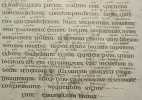 |
|
Ormesby
Psalter, Manuscript Douce 366. DATE:
1310. Provenance East Anglia.
I
believe this now lies in the Oxford Bodleian Library (Douce is a Bod.
title). Manuscript has a number (11 pages) of beautiful historiated
initial letters as seen in the sample image.
A
fine sample of Brown's "Gothic bookhand, England".
|
 folio
147v
folio
147v |
|
 click
to return to Main Latin Resources page
click
to return to Main Latin Resources page
 click
to jump to the MAIN / INDEX page
click
to jump to the MAIN / INDEX page
|
|


















































